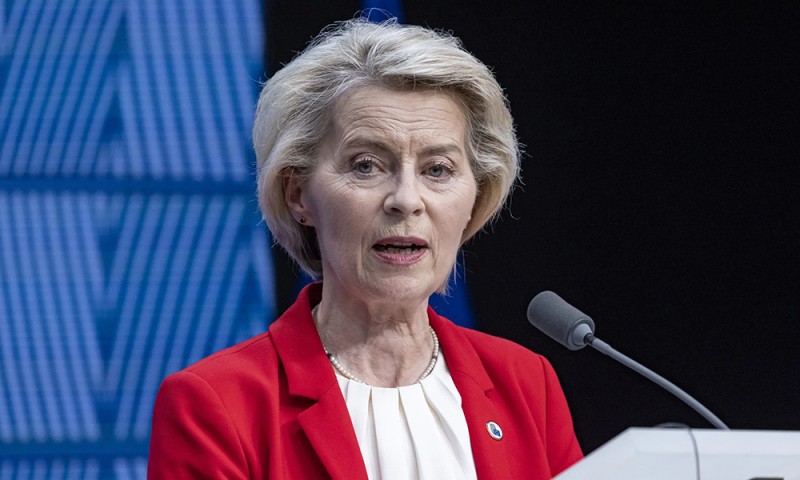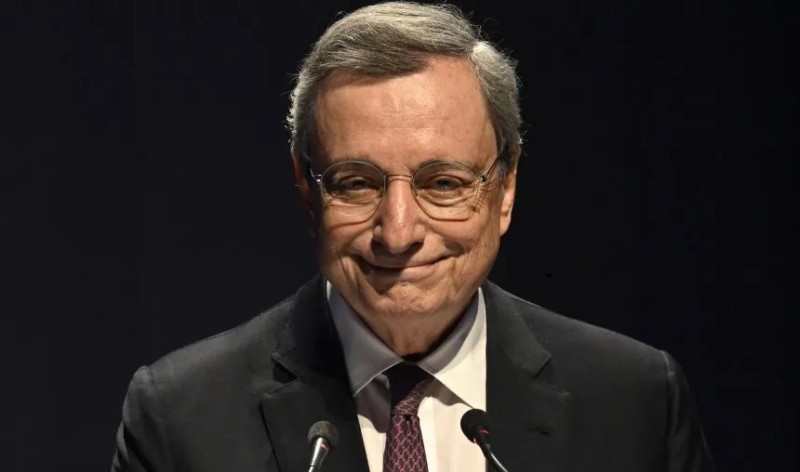
7月初,摩根大通(JPMorgan Chase)CEO杰米·戴蒙在都柏林向听众发表讲话,在谈到欧洲和欧洲企业时说道:“你们正在落后。”他警告称,欧洲在全球GDP中的占比正在下降,并建议需要制定一项促增长议程来弥补这一缺口。他此前曾表示:“欧洲存在一些亟待解决的严重问题。”
在欧盟总部布鲁塞尔,许多人对这种观点表示赞同。毕竟,过去十年,尤其是与美国和中国相比,欧洲的经济增长一直不温不火。在我们《财富》世界500强榜单(按营收对公司进行排名)中,欧洲公司的数量从2004年的142家下降到了2024年的98家。而且在此期间,欧洲几乎没有涌现出新的科技或工业巨头。
然而,欧洲的竞争力问题成为一个如此热门的话题,并非源于戴蒙的分析,而是来自一年前另一位前银行家、欧洲央行(European Central)前行长马里奥·德拉吉的分析。值得注意的是,他将能源置于问题的核心。

除了建议更加关注创新、安全和经济独立外,德拉吉明确地将欧洲大陆的脱碳承诺与各经济体的竞争力联系起来。
德拉吉写道:“如果没有将脱碳收益传递给终端用户的计划,能源价格将继续给经济增长造成压力。全球脱碳行动也是欧盟工业的增长机遇……但无法保证欧洲能够抓住这一机遇。”德拉吉因在全球金融危机中“不惜一切代价”拯救欧元的做法,在欧洲政坛赢得声誉。
他的观点与之前类似、但很快被遗忘的报告并无太大差异。毕竟,欧洲的工业电价可能比美国高出2至4倍,而且除了少数几个小国外,整个欧洲大陆的能源成本都高于其他工业化地区。
但德拉吉发表此番言论时所处的的经济与地缘政治环境,意味着它所传递出的紧迫感更加强烈。
布鲁塞尔智库Bruegel的高级研究员西蒙·塔利亚皮耶特拉表示:“欧洲的经济模式建立在可以获得俄罗斯廉价能源、中国出口市场以及美国安全保障的基础上,而这些如今都已不复存在。这就是德拉吉传达的核心信息。”
目前尚不清楚德拉吉是否曾如此明确地将其分析指向欧洲的对手和盟友:当笔者联系他时,其办公室拒绝对此事置评。但欧洲只有实现能源独立才能提升经济竞争力的观点,正是冯德莱恩主席领导的新一届欧盟委员会(上任不到一年)考虑的一个关键问题。
负责欧盟产业议程的欧盟委员会法国籍执行副主席斯特凡·塞茹尔内表示:“德拉吉报告是欧洲就未来五年必须在欧洲层面构建的新经济环境达成共识的基础。在这些问题上的立场确实发生了转变……脱碳不仅是一项气候计划,更是一项经济战略。”
在政界之外,这种观点也得到了广泛支持。欧洲能源独立、脱碳与工业化计划之间的联系,是今年6月欧盟委员会在布鲁塞尔与包括SAP和宜家(IKEA)领导人在内的60位商界领袖会晤的主要议题之一。
欧洲最大科技公司SAP的CEO克里斯蒂安·克莱因在会后对笔者表示:“俄罗斯不会回来了,因此,我们更应该投资基础设施和电网,以便能够获取其他能源来源。”
英格卡集团(Ingka,宜家)CEO杰斯珀·布罗丁也表示赞同:“俄乌冲突的惨痛教训及其带来的影响表明,所有阵营中的绝大多数人都强烈支持欧洲实现能源独立。”
付诸行动
然而,尽管争取能源独立迫在眉睫,欧洲又如何才能扭转这一局面?欧洲的所有经济指标仍处于黄色或红色预警状态,各国预算也因近期大幅增加国防投资的承诺而日益捉襟见肘。
塔利亚皮耶特拉表示:“根本问题在于,欧洲需要的全部化石燃料都需要进口。欧洲陷入了困局。”
举个例子,北海地区25年前日产440万桶石油当量,如今产量约为100万桶,且这个数字仍在下降。尽管欧盟正在努力摆脱对其主要长期供应国俄罗斯的碳氢燃料的依赖,其日石油消耗超过1,000万桶。
面对这一严峻现实,欧洲希望增加本土能源的产量,增加电力能源占比,并加强各国电网间的互联。这是一项巨大的挑战,因为电力(包括太阳能发电和风电)目前仅能满足欧洲23%的能源需求。但这一次,欧洲正在认真考虑改善电网,实现电网绿化。
“俄罗斯不会回来了,因此,我们更应该投资基础设施和电网,以便能够获取其他能源来源。” SAP的CEO克里斯蒂安·克莱因
塞茹尔内向笔者谈到了他的一个关键计划,即推进“单一市场”建设。例如,他计划引入所谓的“第28种制度”,使企业无需在每个市场设立独立的实体即可在整个欧洲运营。(欧洲有27个成员国,故有“第28种制度”之说。)
其他改革措施也可能有所帮助,包括德拉吉提出的改进或减少欧洲“不一致且限制性的法规”的建议。
最终目标是以一种更加协调的方式激励各类欧洲本土能源(如风能和太阳能)的发展,并更注重执行速度,而不是像过去那样各国各自为政、进展缓慢且高度官僚化的方式。
塔利亚皮耶特拉表示:“欧洲希望各国政府并非仅仅在国家层面规划能源战略,而且……能够与其他欧洲国家充分协调。”(*)
译者:刘进龙
审校:汪皓
7月初,摩根大通(JPMorgan Chase)CEO杰米·戴蒙在都柏林向听众发表讲话,在谈到欧洲和欧洲企业时说道:“你们正在落后。”他警告称,欧洲在全球GDP中的占比正在下降,并建议需要制定一项促增长议程来弥补这一缺口。他此前曾表示:“欧洲存在一些亟待解决的严重问题。”
在欧盟总部布鲁塞尔,许多人对这种观点表示赞同。毕竟,过去十年,尤其是与美国和中国相比,欧洲的经济增长一直不温不火。在我们《财富》世界500强榜单(按营收对公司进行排名)中,欧洲公司的数量从2004年的142家下降到了2024年的98家。而且在此期间,欧洲几乎没有涌现出新的科技或工业巨头。
然而,欧洲的竞争力问题成为一个如此热门的话题,并非源于戴蒙的分析,而是来自一年前另一位前银行家、欧洲央行(European Central)前行长马里奥·德拉吉的分析。值得注意的是,他将能源置于问题的核心。
除了建议更加关注创新、安全和经济独立外,德拉吉明确地将欧洲大陆的脱碳承诺与各经济体的竞争力联系起来。
德拉吉写道:“如果没有将脱碳收益传递给终端用户的计划,能源价格将继续给经济增长造成压力。全球脱碳行动也是欧盟工业的增长机遇……但无法保证欧洲能够抓住这一机遇。”德拉吉因在全球金融危机中“不惜一切代价”拯救欧元的做法,在欧洲政坛赢得声誉。
他的观点与之前类似、但很快被遗忘的报告并无太大差异。毕竟,欧洲的工业电价可能比美国高出2至4倍,而且除了少数几个小国外,整个欧洲大陆的能源成本都高于其他工业化地区。
但德拉吉发表此番言论时所处的的经济与地缘政治环境,意味着它所传递出的紧迫感更加强烈。
布鲁塞尔智库Bruegel的高级研究员西蒙·塔利亚皮耶特拉表示:“欧洲的经济模式建立在可以获得俄罗斯廉价能源、中国出口市场以及美国安全保障的基础上,而这些如今都已不复存在。这就是德拉吉传达的核心信息。”
目前尚不清楚德拉吉是否曾如此明确地将其分析指向欧洲的对手和盟友:当笔者联系他时,其办公室拒绝对此事置评。但欧洲只有实现能源独立才能提升经济竞争力的观点,正是冯德莱恩主席领导的新一届欧盟委员会(上任不到一年)考虑的一个关键问题。
负责欧盟产业议程的欧盟委员会法国籍执行副主席斯特凡·塞茹尔内表示:“德拉吉报告是欧洲就未来五年必须在欧洲层面构建的新经济环境达成共识的基础。在这些问题上的立场确实发生了转变……脱碳不仅是一项气候计划,更是一项经济战略。”
在政界之外,这种观点也得到了广泛支持。欧洲能源独立、脱碳与工业化计划之间的联系,是今年6月欧盟委员会在布鲁塞尔与包括SAP和宜家(IKEA)领导人在内的60位商界领袖会晤的主要议题之一。
欧洲最大科技公司SAP的CEO克里斯蒂安·克莱因在会后对笔者表示:“俄罗斯不会回来了,因此,我们更应该投资基础设施和电网,以便能够获取其他能源来源。”
英格卡集团(Ingka,宜家)CEO杰斯珀·布罗丁也表示赞同:“俄乌冲突的惨痛教训及其带来的影响表明,所有阵营中的绝大多数人都强烈支持欧洲实现能源独立。”
付诸行动
然而,尽管争取能源独立迫在眉睫,欧洲又如何才能扭转这一局面?欧洲的所有经济指标仍处于黄色或红色预警状态,各国预算也因近期大幅增加国防投资的承诺而日益捉襟见肘。
塔利亚皮耶特拉表示:“根本问题在于,欧洲需要的全部化石燃料都需要进口。欧洲陷入了困局。”
举个例子,北海地区25年前日产440万桶石油当量,如今产量约为100万桶,且这个数字仍在下降。尽管欧盟正在努力摆脱对其主要长期供应国俄罗斯的碳氢燃料的依赖,其日石油消耗超过1,000万桶。
面对这一严峻现实,欧洲希望增加本土能源的产量,增加电力能源占比,并加强各国电网间的互联。这是一项巨大的挑战,因为电力(包括太阳能发电和风电)目前仅能满足欧洲23%的能源需求。但这一次,欧洲正在认真考虑改善电网,实现电网绿化。
“俄罗斯不会回来了,因此,我们更应该投资基础设施和电网,以便能够获取其他能源来源。” SAP的CEO克里斯蒂安·克莱因
塞茹尔内向笔者谈到了他的一个关键计划,即推进“单一市场”建设。例如,他计划引入所谓的“第28种制度”,使企业无需在每个市场设立独立的实体即可在整个欧洲运营。(欧洲有27个成员国,故有“第28种制度”之说。)
其他改革措施也可能有所帮助,包括德拉吉提出的改进或减少欧洲“不一致且限制性的法规”的建议。
最终目标是以一种更加协调的方式激励各类欧洲本土能源(如风能和太阳能)的发展,并更注重执行速度,而不是像过去那样各国各自为政、进展缓慢且高度官僚化的方式。
塔利亚皮耶特拉表示:“欧洲希望各国政府并非仅仅在国家层面规划能源战略,而且……能够与其他欧洲国家充分协调。”(*)
译者:刘进龙
审校:汪皓
“You’re losing,” JPMorgan Chase CEO Jamie Dimon told an audience in Dublin earlier in July, speaking about Europe and its companies. He warned of the continent’s declining share in global GDP, and suggested a pro-growth agenda was needed to make up for the shortfall. “Europe has some serious issues to fix,” he had previously said.
Back in Brussels, many were nodding in agreement. After all, European growth has been tepid in the past decade, particularly compared to the US and China. In our own Fortune 500 Global list, which ranks companies by revenue, the number of European companies fell back from 142 in 2004 to 98 in 2024. And almost no new tech or industrial giants have emerged out of Europe in that time.
Yet it wasn’t Dimon’s analysis, but that from another one-time banker, former European Central Bank president Mario Draghi, a year earlier, that made competitiveness such a hot issue. Notably, he put energy at the center of it.
Alongside recommending a greater focus on innovation, security and economic independence, Draghi explicitly linked the continent’s commitment to decarbonization with the competitiveness of its economies.
“Without a plan to transfer the benefits of decarbonization to end-users, energy prices will continue to weigh on growth. The global decarbonization drive is also a growth opportunity for EU industry… yet it is not guaranteed that Europe will seize this opportunity,” wrote Draghi, who minted his reputation in European politics with his “whatever it takes” approach to saving the euro in the global financial crisis.
His message wasn’t that different from similar, previous reports that were quickly forgotten. After all, European industrial electricity prices can be 2-4 times higher than in the U.S., and with the exception of a few smaller countries, energy costs throughout the continent are higher than elsewhere in the industrialized world.
But the economic and geopolitical context in which Draghi delivered his message meant that this time it carried a heightened sense of urgency.
“Europe built its economic model around access to cheap energy from Russia, export markets in China, and security guarantees from the U.S., and none of these things are there anymore. That was the underlying message from Draghi,” Simone Tagliapietra, a senior fellow at the Brussels-based Bruegel think tank, says.
Whether Draghi ever made his analysis so explicitly about Europe’s adversaries and allies isn’t clear: his office declined to comment on the matter when I reached out. But the idea that Europe’s economic competitiveness could only improve if it becomes energy independent, is a key consideration of President von der Leyen’s new European Commission, which started its term less than a year ago.
“The Draghi report is the foundation of the European consensus on the new economic context that must be built at the European level for the next five years,” Stéphane Séjourné, the French Executive Vice President of the European Commission, in charge of the bloc’s industrial agenda, says. “There has truly been a change in approach on these issues… decarbonization is not just a climate plan, it is an economic strategy.”
There is broad support beyond politics too. The link between Europe’s energy independence, decarbonization and industrialization plans was one of the main agenda items in a meeting between the European Commission and 60 business leaders, including the leaders of SAP and IKEA, this past June in Brussels.
“Russia won’t come back,” Christian Klein, CEO of SAP, Europe’s largest tech company, told me following that meeting. “So we should rather invest in infrastructure and the grid to have access to other sources of energy.”
Jesper Brodin, the CEO of Ingka (IKEA) agreed: “The hard-learned lesson of Russia’s invasion of Ukraine, and what it meant, is that there is a very strong majority in all camps for European energy independence.”
Making the change
But how can Europe even begin to turn this tide, even if the sense of urgency is real? All of Europe’s economic indicators are still blinking yellow or red, and national budgets are increasingly constrained by recent commitments to invest massively more in defense.
“The fundamental problem is that Europe imports all the fossil fuels it needs,” Tagliapietra said. “Europe is trapped.”
To give an idea, the North Sea, which 25 years ago produced 4.4 million barrels of oil equivalent a day, now produces around 1 million, a figure that is still dropping. The EU alone consumes over 10 million a day, even as it pushes to wean itself off hydrocarbons from Russia, which was its primary long-term supplier.
Faced with this stark reality, Europe wants to generate more homegrown energy, more energy from electricity, and more links between countries’ electricity grids. It’s hardly a small challenge, as electricity (including solar and wind) still only supplies 23% of Europe’s energy needs. But this time Europe is serious about improving and greening the grid.
“Russia won’t come back. So we should rather invest in infrastructure and the grid to have access to other sources of energy.” Christian Klein, CEO of SAP
Séjourné told me of his plans to advance the “single market”, as one key aspect. He plans to introduce a so-called “28th regime”, for example, so companies can operate all over Europe without having to establish separate entities in each market. (Europe has 27 member states, hence the notion of a 28th regime.)
There are other reforms that could help too, including Draghi’s suggestions of improving or reducing Europe’s “inconsistent and restrictive regulations”.
The goal is ultimately to incentivize the development of all types of European-produced energy, such as wind and solar, in a more coordinated way—and with more focus on speed of execution, compared to the country-by-country, slow, and highly bureaucratic ways of the past.
“Europe wants to go to a world where governments are not planning their energy strategies at the national level only, but… in a way that is fully coordinated with other European countries,” Tagliapietra said.

